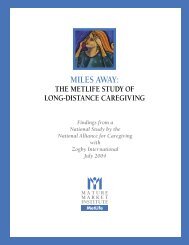Congregational Health Ministry Survey Report - National Caregivers ...
Congregational Health Ministry Survey Report - National Caregivers ...
Congregational Health Ministry Survey Report - National Caregivers ...
Create successful ePaper yourself
Turn your PDF publications into a flip-book with our unique Google optimized e-Paper software.
Taken as a whole, the patterns of service to congregation and community underscores the extent to which congregationalinvolvement in health services is viewed by congregations as a ministry within the broader community rather than an intramuralbenefit of church membership.AdvocacyAs might have been expected, public policy advocacy was a far less common practice,although among the congregations who practice health care advocacy, there is a wide array ofapproaches to this activity. Advocacy can be understood as efforts to inform and/or urge actionon health policies and practices on a systemic level, usually involving public officials. Thevariety and frequency of these advocacy activities is shown in Table 16. About a quarter of allcongregations engaged in any form of advocacy. Of these, 60% of congregations (15% of allcongregations) participated in two or more forms of advocacy. When hearing sermons on advocacyissues is included, fully 35% of congregations have one or more advocacy practices.A health advocacy scale was produced incorporating all advocacy activities except“hearing a health advocacy sermon”. Controlling for other characteristics, larger congregations,African American congregations, as well as suburban and downtown congregations weresignificantly more likely to engage in advocacy. White and rural congregations engaged insignificantly less advocacy. Similarly some denominational differences in response were observed.Table 16 - AdvocacyHeard Sermons 19%Discuss Policy 11%Voter Education 10%Communicate with Government 10%Meeting with <strong>Health</strong> Institutions 10%Letters 7%Petition 6%Internet 5%Rallies 3%Other 3%None 44%engaged in significantly more advocacy activities, controlling for the role of sermons.In general regional patterns were not observable with the exception of California.At the time of the survey California was engaged in a statewide reform effort with regard tohealth care coverage. This timing may account for the finding that the California churchesin the sample engaged in advocacy substantially more than the sample as a whole. This performancewas 11% above the mean in the sample as a whole.Incorporation of whether or not the congregation heard sermonson health advocacy issues went hand in hand with an additional17% of increase in congregational advocacy by itself. Furthermore, iteliminated the predictive significance of being an African Americanor suburban congregation. That is, African American congregations,or suburban congregations, are simply more likely to have heard sermonson advocacy, which we observed occurs together more oftenthan expected with more advocacy activities. African Americanchurches without a pastor who advocates are no more likely than Hispanicor Asian congregations to engage in advocacy. White congregations,even allowing for the effect of advocacy sermons, engaged inless advocacy. Larger congregations and downtown congregationsWHY DO SOME CONGREGATIONS ENGAGE INHEALTH CARE MINISTRIES AND OTHERS DO NOT?As has been suggested by several of the findings above, size of congregation hasbeen shown to be a significant factor in predicting congregational engagement in education,direct service or advocacy activities related to health care. But size alone is not sufficient topredict broad and multifaceted embrace of health care as a field of ministry activity. Ourreflection on both the statistical analysis and the substantial anecdotal information that wasreceived with the returned surveys suggests a more complex confluence of factors. Thesefactors, taken together might be described as capacity, leadership and opportunity.Capacity often comes with size especially as relates to organizational coherence,financial and human resources and a congregational orientation toward active programmingin addition to the worship activities of the congregation. Capacity is also measured in termsof the stature of the congregation within the community and whether it is looked to within8
the community as a source of community service and programming in relation to issues such aschild care, feeding programs or homeless shelter. <strong>Congregational</strong> literature often emphasizes the“200 mark” of membership above which programming becomes not only expected but critical toinstitutional membership. While there are considerable and notable exceptions to this rule ofthumb, these data corroborate this tendency especially in provision of direct services beyond thecongregational membership. Finally, capacity may be understood in terms of congregational selfperceptionof having skills and or services sufficient to address needs within the complex world ofhealth care. Even small congregations with members willing and able to assist others in completingcomplex insurance forms or schedule transportation to a series of medical treatments, is inpossession of considerable capacity.FUNDING HEALTH CARE MINISTRIESRespondents were asked to identify the sources offinancial support for their various health ministries. Thisportion of the survey was not designed to match specificfunding sources with particular health ministries. Rather,we sought to have respondents identify all sources of supportfor their health care ministries. This approach resultedin rich anecdotal evidence rather than a statistical analysis.Congregations appear to have a rather entrepreneurialspirit developing the financial support they need to underwritethe particular health ministries. In addition to thecongregational budget; “special offerings,” donor givings,community funding sources were reported as sources of support.Frequently “state sources” of funding were identifiedwith a wide array of specific programs noted such as stateoffice for older adults, Title XX (related to child care healthprograms), recovery monies (from Gulf Coast state referringto Katrina recovery efforts, alcohol and drug programs offeredby the states was also reported.Support for congregational programs comes alsothrough in-kind contributions. This may take the form ofprinted materials or professional services. Such in-kind contributionscongregations report receiving from local andstate health offices, American Red Cross, local hospitals,medical and dental schools and donated transportation froma local bus company. Of particular mention were electronicand print resources as well as encouragement and technicalassistance from their respective denominational offices.In short, local congregations tap a number of diversesources to garner the financial support they need to establishand minister their health care ministries. In doing so, thecongregations form partnerships with governmental educationaland charitable organizations within their communitiesas well as obtaining contributions of funds or material fromtheir respective denominational sources.Leadership appears to be a critical element incongregational provision of education, direct service andpolicy advocacy activities. The study strongly suggeststhe importance of pastoral leadership in enabling congregationalparticipation in policy advocacy. With regard tohealth education and direct service provision as well asadvocacy activities, a number of other sources of leadershipwere noted in the anecdotal material. Parish nurses,and far less commonly, health ministers too, provide crucialleadership in forming and maintaining health initiativeswithin congregations. A surprising number of othersources of leadership for congregations in their pursuit ofhealth care activities were identified. Denominational staffor coordinators specifically focused on health ministrieswere commonly recognized as resources. While there isby no means such a role identified in each denomination,in those instances in which there are such persons, localcongregations look to them for assistance and leadership.That leadership comes in both print and electronic materials,conferences and especially in identification of experience-basedor “best practice” models. Leadership is alsosometimes available from local ecumenical agencies focusedon health care and operates across denominationallines often in relation to local or state councils of churches.Finally, leadership comes from key lay persons within thecongregation with specialized health care knowledge.Numerous comments within returned surveys highlightedthe leadership roles of retired doctors, nurses, medicaltechnicians and social workers initiating and staffing variousprograms of education and direct service. The role ofkey lay leaders in making health ministry happen in congregations,how laypersons interact with the pastor, howvoluntary involvement translates into programming, areundoubtedly fruitful areas for further research.Opportunity might express a final critical elementin relation to congregational provision of health care programs of education, direct service and advocacy. This matter of opportunityis related to leadership but is also closely related to awareness of health needs in the specific community surrounding thecongregation. Opportunity seems to present itself through a variety of means judging from the anecdotal responses from the sample.<strong>Health</strong> events initiated by a municipal office or neighboring hospital may serve to quicken a congregation’s awareness of the needfor greater education about diabetes or hypertension, for example. Cover the Uninsured Week has been instrumental in calling the9
attention of congregations to the needs of those--within both congregationand community--who skip medical appointments or fail to have prescriptionsfilled when they lack insurance coverage. Sponsoring or serving asvolunteers at homeless shelters often awakens congregational awarenessof chronic physical and mental health needs among that population. Thisawareness, in fact, becomes opportunity for service as congregationalmembers seek to find ways to address unmet needs. It is not uncommonfor congregations to discover holes in the fabric of the health care systemand seek to address such needs directly through preventative education,medical services or advocacy.Within congregational life then, capacity, leadership and opportunity,it seems form a kind of “fire triangle” which best explains the combustionthat results in congregational initiation of health care ministries of education, direct service and advocacy. The form whichthat initiative takes is unique to the community and to the congregation. The patterns of activity that were reported in this sample arehighly differentiated and conform to few norms. <strong>Health</strong> ministries are undertaken by congregations alone, with other congregationsor in partnership with secular organizations in relation to a dizzying array of health issues and needs. Some are directed primarily tomeet the needs of congregational members and others are offered without cost to any in need. Some are complex and expensive operations,which require extensive financial support garnered often from sources outside the congregation. Other programs are operatedentirely within the modest budgets of the church. While no questions on the survey addressed the longevity of congregationallybased health care programs, anecdotal information suggests that such programs are expanding in size and moreover, that the numberof congregations finding health care services as a part of their own sense of mission is growing.WHAT ARE THE IMPLICATIONS OF THIS STUDY?The rich fabric of congregational involvement in health education, direct service and public policy advocacy hold numerousimplications for institutions related to congregational ministry and/or to health care. Our purpose in reporting these data fully asrepresented in the tables is to enable these groups to examine the data and draw their own conclusions.The <strong>National</strong> Council of Churches and its member communions recognize in the findings of the study considerable confirmationthat local faith based organizations can and do play an important role within the complex picture of health care in America.The study confirms, as well, the reality that congregations look to national denominational and ecumenical structures for a variety ofinstitutional supports related to these ministries. <strong>National</strong> denominations and ecumenical agencies will likely wish to review andstrengthen their respective relationships with congregational health ministries in a number of ways which may include:Creation and/or maintenance of networks of congregations engaged in health ministries.Establish or strengthen national staff structures which relate to health-engaged congregations.Development of electronic communications and print and electronic resource materials.Consider incentives to congregations to explore involvement in health care ministries through time limited “healthevents.”Sponsor conferences, perhaps ecumenically, to advance training, provide resources and to nurture these ministries.Prepare and disseminate sermon resources related to the health care system and policy reform.As health care public policy debates arise in the national agenda, denominations working together, will want to drawfrom the lived experiences of local congregations in providing testimony regarding the unmet health care needs of thecommunities they serve.Denominations will likely wish to reason together about the ways to celebrate, augment and extend to more congregationsthe kinds of health care efforts reported in this study.10
<strong>National</strong> church agencies will surely want to learn more about congregations that did not respond and what preventsthem from engagements in health care ministries within their communities.A related inquiry may address the question of what types of local planning and coordination bodies (committee, deacons,pastor alone, etc.) best address the kinds of decision-making that results in effective health programming.Acting together denominational agencies will want to learn more about the kinds and types of organizations which partnerwith congregations on the local level and, as may be appropriate, explore the nature of the relationship at the nationallevel between such organizations.Local and state health departments may see within the findings of this study potential for working in partnership with localcongregations to reach underserved populations.Congregations themselves may draw some satisfaction from the multifaceted health ministries highlighted by this study andmay adapt or expand their own practices.Policy advocates should be heartened to discover the willingness and capacity of local congregations for advocacy activitiesand may want to ask how this capacity can be maximized within state and national public policy debates.Researchers might well find in this study a rough mapping of the terrain of health care among diverse congregations andseek to further explore matters such as how the programs began and how they are maintained, as well as the number of personsserved and approximations of the aggregated financial value of such programs within the national health care economy. High priorityshould be given to the development and application of research which might effectively explore minority and marginalized communitieswhere health disparities are acute. Too, they may wish to inquire as to the training, recordkeeping and substance of the advocacyactivities in congregations.In the present national moment it is likely that adequate healthcare policies will only be established through a thorough and wellframednational debate. Communities of faith bring with them not onlyyears of experience in meeting health needs locally but a commitment tothe common good. The findings of this modest study might well make acontribution in heightening awareness, providing evidence of the kindsof needs that have not been met under current policies and especially inidentifying thousands of congregations and tens of thousands of volunteerswho daily step forward in acts of kindness to secure a better future for others. To the degree this study has provided them witha voice in this important societal debate, we are grateful.Table 1 — Number of responses, by DenominationDenomination NameThe United Methodist Church*Presbyterian Church (U.S.A.)*Number of Returned <strong>Survey</strong>s25161240Note for Table 1: Congregations reporting more than oneaffiliation are reflected separately under each groupOthers include:"Pentecostal" (29), Church of God (Cleveland, Tennessee) (26),"Baptist" (21), Willow Creek (14), Christian Church (Disciples of Christ) inthe United States and Canada* (12), Non-Denominational (12), The CatholicEvangelical Lutheran Church in America* 956 Church (10), Reformed Church in America* (10), United Pentecostal ChurchUnited Church of Christ* 743International (8), Assemblies of God (6), International Pentecostal HolinessChurch (6), "None" (6), <strong>National</strong> Baptist Convention, U.S.A., Inc.* (5),Episcopal Church* 172 Church of God of Prophecy (4), Church of the Brethren* (4), Churches ofMissing, Ambiguous, or Unknown Group 164God, General Conference (4), Pentecostal Assemblies of the World, Inc. (4),Islam (mainstream) (3), Pentecostal Church of God (3), "Church of God" (2),Philadelphia Yearly Meeting of the Religious Society of Friends* (2), AfricanAmerican Baptist Churches in the U.S.A.* 43 Methodist Episcopal Church* (1), The African Methodist Episcopal ZionProgressive <strong>National</strong> Baptist Convention, Inc.* 39Church* (1), Baptist General Conference (1), Christian Methodist EpiscopalChurch* (1), Church of God, General Conference (Atlanta, GA) (1), TheChurch of God (Anderson, Indiana) 38Church of God (Seventh Day), Denver, Colorado (1), Church of the Nazarene(1), Concilio de Iglesisas de Cristo Misionera, M.I. (1), The EvangelicalThe Church of God in Christ 37 Church Alliance (1), Full Gospel Fellowship of Churches and Ministers International(1), IFCA International, Inc. (1), International Church of the FoursquareGospel (1), International Council of Community Churches* (1), JewishOthers 217(1), Lutheran Congregations in Mission for Christ (1), Mennonite ChurchUSA (1), Mount Sinai Holy Church of America, Inc. (1), <strong>National</strong> Associationof <strong>Congregational</strong> Christian Churches (1), The Orthodox Church in America* (1), Polish <strong>National</strong> Catholic Church of America* (1), Seventh-day Adventist Church (1), Southern BaptistConvention (1), Union Missionary Baptist Association (1), Unitarian Universalist Association of Congregations (1), United Holy Church of America (1), Worldwide Church of God (1)*Denotes a Member Communion of the <strong>National</strong> Council of Churches USA11
Table 7— Who is Served?Clinic 20%For Congregation 4% <strong>Health</strong> Minister 5%For Community 6% For Congregation 2%For Both 12% For Community 0%Referrals 16% For Both 2%For Congregation 4% Daycare <strong>Health</strong> 8%For Community 4% For Congregation 1%For Both 8% For Community 2%Screening 27% For Both 3%For Congregation 7% Counseling 22%For Community 5% For Congregation 7%For Both 16% For Community 2%Support Group 20% For Both 11%For Congregation 4% Counseling (provide service) 20%For Community 5% For Congregation 7%For Both 12% For Community 2%Exercise 23% For Both 11%For Congregation 7% Counseling (Referrals) 32%For Community 4% For Congregation 12%For Both 13% For Community 3%12-Step Program 32% For Both 17%For Congregation 2% Emergency Medical Funding 25%For Community 13% For Congregation 8%For Both 18% For Community 5%Parish Nurse 18% For Both 12%For Congregation 10%For Community 1%For Both 6%© <strong>National</strong> Council of Churches USA475 Riverside Drive, Suite 880New York, NY 10115(888)870-332512









